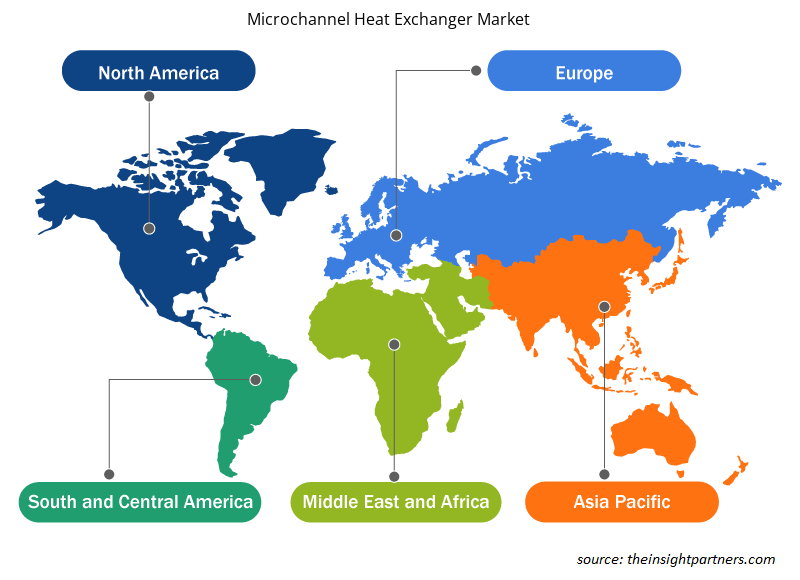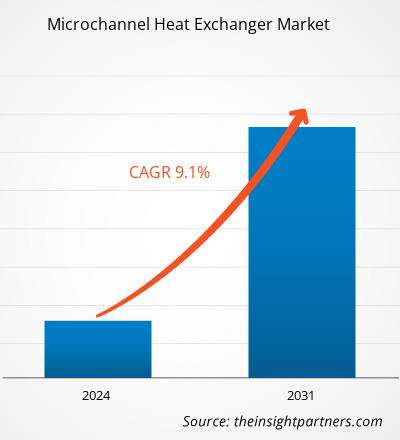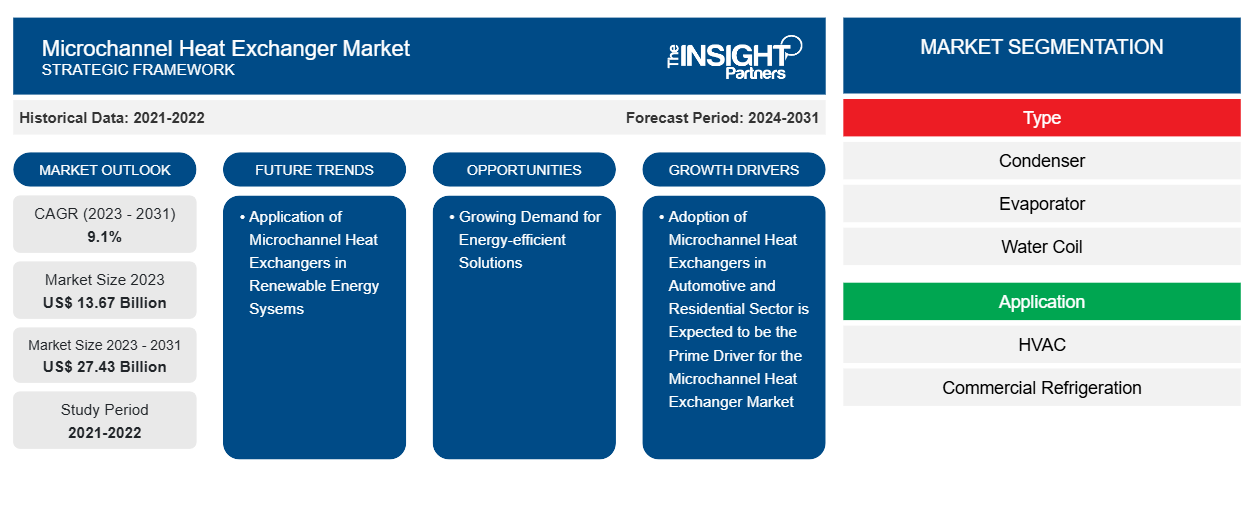微通道热交换器市场规模预计将从 2023 年的 136.7 亿美元增至 2031 年的 274.3 亿美元。预计 2023-2031 年市场复合年增长率将达到 9.1%。微通道热交换器因其能源效率和降低制冷剂充注量的能力而适用于住宅和商业空调系统以及制冷设备。微通道热交换器主要用于加热和冷却目的。汽车行业的不断发展成为微通道热交换器市场的主要推动力。
微通道热交换器市场分析
微通道热交换器可用于多种应用,例如火箭发动机、涡轮叶片、混合动力汽车、制冷冷却、氢存储、微重力热控制和毛细管泵回路。热通量去除的要求主要根据应用类型而发生显著变化。微通道热交换器的应用在消除紧凑系统(如激光二极管和核聚变、高性能计算机芯片和裂变反应堆)的高热通量方面发挥着重要作用,以确保其性能稳定且使用寿命长。
微通道热交换器市场概况
微通道热交换器用于制冷和空调系统。随着技术的不断进步,世界对小型化越来越青睐。因此,从紧凑系统中去除高热通量变得至关重要。市场按类型和应用进行分类。根据类型,微通道热交换器市场分为冷凝器、蒸发器和水盘管。根据应用,市场分为暖通空调、商用制冷和其他。
定制此报告以满足您的需求
您可以免费定制任何报告,包括本报告的部分内容、国家级分析、Excel 数据包,以及为初创企业和大学提供优惠和折扣
-
获取此报告的关键市场趋势。这个免费样品将包括数据分析,从市场趋势到估计和预测。
微通道热交换器市场驱动因素和机遇
汽车和住宅领域采用微通道热交换器有望成为微通道热交换器市场的主要驱动力
微通道热交换器在汽车和家用空调中的应用日益广泛,成为微通道热交换器市场的主要推动力。微通道热交换器被认为比传统的翅片管热交换器更有效,主要用于家用空调。微通道热交换器有助于减少家用空调系统中的制冷剂量,从而提高能源效率。微通道热交换器应用于汽车领域电子设备的冷却。由于对小型化和紧凑型设备的需求不断增长,微通道热交换器非常适合用于汽车空调系统。
对节能解决方案的需求不断增长
近年来,消费者对节能电器的偏好日益增加。节能可以降低对新基础设施的投资需求,从而减少总体电力需求,带来长期效益。为了实现节能,许多终端用户行业都在使用高能效空调和制冷剂系统。节能制冷和空调系统比传统系统消耗更少的能源,运行效率更高,从而降低碳足迹。节能制冷剂和冷却系统可用于住宅、商业和工业设施,以降低能源成本和温室气体排放。因此,对节能解决方案的不断增长的需求推动了微通道热交换器市场的发展。
微通道热交换器市场报告细分分析
有助于得出微通道热交换器市场分析的关键部分是类型和应用。
- 根据类型,市场分为冷凝器、蒸发器和水盘管。冷凝器部分在 2023 年占据了更大的市场份额。
- 从应用方面来看,市场细分为暖通空调、商用制冷和其他领域。暖通空调领域在 2023 年占据了市场主导地位。
微通道热交换器市场份额按地区分析
微通道热交换器市场报告的地理范围主要分为五个区域:北美、欧洲、亚太、中东和非洲、南美。
2023 年,亚太地区引领微通道热交换器市场。亚太地区包括中国、印度、澳大利亚、日本和韩国。汽车和 HVAC 公司在市场中的高存在感是推动市场发展的主要因素。从事微通道热交换器制造的公司正致力于通过为汽车和住宅领域提供更紧凑的解决方案来扩大其产品供应。微通道热交换器的集成可提高空调系统的能源效率,这也是推动市场发展的主要因素。人们对制冷和冷却系统环保选项的日益关注也推动了微通道热交换器的应用,预计这将推动亚太地区市场在预测期内的发展。
微通道热交换器市场区域洞察
Insight Partners 的分析师已详细解释了预测期内影响微通道热交换器市场的区域趋势和因素。本节还讨论了北美、欧洲、亚太地区、中东和非洲以及南美和中美洲的微通道热交换器市场细分和地理位置。

- 获取微通道热交换器市场的区域特定数据
微通道热交换器市场报告范围
| 报告属性 | 细节 |
|---|---|
| 2023 年的市场规模 | 136.7亿美元 |
| 2031 年市场规模 | 274.3亿美元 |
| 全球复合年增长率(2023 - 2031) | 9.1% |
| 史料 | 2021-2022 |
| 预测期 | 2024-2031 |
| 涵盖的领域 |
按类型
|
| 覆盖地区和国家 |
北美
|
| 市场领导者和主要公司简介 |
|
微通道热交换器市场参与者密度:了解其对业务动态的影响
微通道热交换器市场正在快速增长,这得益于终端用户需求的不断增长,而这些需求又源于消费者偏好的不断变化、技术进步以及对产品优势的认识不断提高等因素。随着需求的增加,企业正在扩大其产品范围,进行创新以满足消费者的需求,并利用新兴趋势,从而进一步推动市场增长。
市场参与者密度是指在特定市场或行业内运营的企业或公司的分布情况。它表明在给定市场空间中,相对于其规模或总市场价值,有多少竞争对手(市场参与者)存在。
在微通道热交换器市场运营的主要公司有:
- API 传热公司
- 气候 SL
- 丹佛斯
- 电装公司
- 翰农系统
- 卡尔特拉
免责声明:上面列出的公司没有按照任何特定顺序排列。

- 了解微通道热交换器市场顶级关键参与者概况
微通道热交换器市场新闻和最新发展
通过收集主要和次要研究后的定性和定量数据来评估微通道热交换器市场,其中包括重要的公司出版物、协会数据和数据库。以下是微通道热交换器市场的发展和战略列表:
- 2024 年 4 月,Kaltra 为其微通道热交换器推出了一种高耐腐蚀铝合金 AA3F05(回火温度为 H112)。(来源:Kaltra,新闻稿/公司网站/时事通讯)
- 2024 年 2 月,丹佛斯印度公司在 ACREX India 2024 展览会上推出了其微通道热交换器技术。该节能技术通过其高端的下一代蒸发器彻底改造了风冷机组,与传统的翅片管热交换器相比,它具有更高的优势。(来源:丹佛斯,新闻稿/公司网站/通讯)
微通道热交换器市场报告覆盖范围和交付成果
“微通道热交换器市场规模和预测(2021-2031)”报告对以下领域进行了详细的市场分析:
- 范围内所有主要细分市场的全球、区域和国家层面的市场规模和预测
- 市场动态,如驱动因素、限制因素和关键机遇
- 未来的主要趋势
- 详细的PEST分析
- 全球和区域市场分析涵盖关键市场趋势、主要参与者、法规和最新市场发展
- 行业格局和竞争分析,涵盖市场集中度、热点图分析、知名参与者和最新发展
- 带有 SWOT 分析的详细公司简介
- 历史分析(2 年)、基准年、预测(7 年)及复合年增长率
- PEST和SWOT分析
- 市场规模、价值/数量 - 全球、区域、国家
- 行业和竞争格局
- Excel 数据集
近期报告
相关报告
客户评价
购买理由
- 明智的决策
- 了解市场动态
- 竞争分析
- 客户洞察
- 市场预测
- 风险规避
- 战略规划
- 投资论证
- 识别新兴市场
- 优化营销策略
- 提升运营效率
- 顺应监管趋势























 获取免费样品 - 微通道热交换器市场
获取免费样品 - 微通道热交换器市场